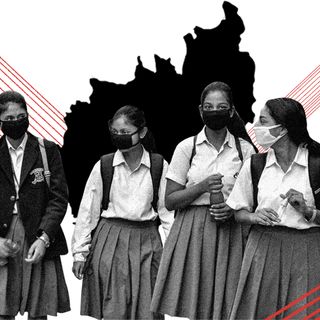
In India, the Average Age of Hysterectomy Is 34. Why Are Women Undergoing the Irreversible Procedure So Young?
“If you’re entering menopause 10 years before you should be, what is that doing to women’s health?”

Google hysterectomy in India, and you’ll find terrifying and outrageous news articles of exploitation. From doctors prescribing the surgery unnecessarily in order to profit, to employers mandating the surgery to maximize workers’ productivity, the uterus makes headlines only when women are tricked or exploited.
While these isolated stories do need to be told, they disguise a more complicated, undiscussed, and larger-scale truth: the drivers of the surgery across India are less nefarious and more systemic. The issue of hysterectomy is a case study in everything that is wrong with women’s gynecological health awareness and care in a patriarchal society that has little use for the uterus once it has produced babies and few options to treat the disorders that can plague it.
“The bottom line is, we don’t take gynecological morbidity seriously enough,” says Sapna Desai, PhD, an epidemiologist and women’s health researcher for the Population Council who has studied hysterectomy.
The result is not a particularly high prevalence of hysterectomy across India (though some states’ statistics bear scrutiny) so much as a startlingly young average age – just 34 – at which the surgery is performed. More than 10 years before the average age of menopause, such early hysterectomy could herald an overlooked public health problem in years to come.
***
A hysterectomy is an operation to remove a woman’s uterus. It is the most common surgery among women everywhere, other than a C-section. However, the term hysterectomy is also commonly used to refer to the accompanying removal of ovaries, Fallopian tubes, cervix, and/or other related features. According to India’s fourth National Family Health Survey (2015-16), the most recent data available, the most common issues that lead to a hysterectomy are pain and/or heavy bleeding. For Gayatri Lobo, 41, of Mumbai, a years-long struggle with both due to endometriosis culminated in the surgery. During that time, she underwent two procedures to remove the rogue endometrial tissue and tried hormone treatment to prevent further growths. But the medication made her throw up every single morning. Her doctor suggested she wait until she was closer to menopause to have a hysterectomy, but Lobo felt like she had tried everything. At age 39, her uterus was removed.
“It was the best decision I’ve taken,” she says.
But Lobo’s story represents the best-case scenario of hysterectomy in India: A woman who had treatment options, who understood them, and who received care early. This is the lens through which to examine hysterectomy, Desai says. “Are women given the full set of options and information that they need about gynaecological morbidity and where hysterectomy fits in?” she says.
India’s early average age of hysterectomy suggests many women aren’t getting those options. Lack of access to gynecological care outside of pregnancy, poor awareness around gynecological disorders, a lack of medical skill in gynecological disease management and surgery, and attitudes that see the uterus as being disposable post-children combine to make early hysterectomy a fait accompli for many women. Although all these factors exist in different degrees in different parts of the country, what remains constant is limitation.
Related on The Swaddle:
Landmark Study Shows HPV Vaccine Protects Against Invasive Cervical Cancer
Preventative health care is virtually non-existent in many parts of the country, both in terms of access and understanding, and some women’s first brush with gynecological health care begins and ends with pregnancy.
Even when women do obtain care early for a gynecological morbidity, or disorder, any abnormality with the uterus is frequently associated with cancer, says Dipti Govil, PhD, an assistant professor at the International Institute for Population Sciences whose doctoral dissertation focused on hysterectomy. During her research, which focused on hysterectomy in Moradabad District, Uttar Pradesh, most women who had undergone the surgery told her it had been necessary to remove a tumor. But they didn’t know what kind or why it had occurred. So Govil looked at their medical records, nearly all of which listed rasoli – boil, in English, but used to convey a tumor, or growth – with no other details.
“I asked [doctors], ‘Why you have written everywhere rasoli as the cause of hysterectomy?’” she recounts. Their reply: “It’s a very convenient and convincing communication to a layman.”
She sought details from operating theater staff, but ran into a roadblock there, too. “If the uterus needs to be removed, what is the need to know the real cause of the problem?” they told her.
Rasoli could be anything, Govil says – for instance, fibroids, which are benign growths. While fibroids, depending on their size and number, can cause excess bleeding and pain, they are widely misunderstood to be a precursor to cancer. As with any tissue in the body, it is possible for a fibroid to become cancerous, but it is extremely rare. Still, the fear of a worsening disorder or eventual cancer and possible death makes a pre-menopausal hysterectomy seem like the best choice to many younger women.
“One night I had severe pain in [my] abdomen, just like delivery pains. My husband took me to [a] doctor where he gave injection and saline. Next day, the doctor did the sonography and told us that there are fibroids in your uterus and you will need surgery, otherwise these fibroids will grow. My husband went to meet other doctors to get second opinion; all of them said that the surgery was necessary,” one 36-year-old woman, who underwent a hysterectomy at age 28, told Nilgani Sardeshpande, PhD, during the latter’s study of hysterectomy among young rural women in Maharashtra.
Surgery may have been necessary – but that surgery doesn’t always have to be hysterectomy, says Dr. Deeksha Pandey, OB/GYN and professor with Kasturba Medical College, Manipal Academy of Higher Education. For the past 10 years, Dr. Pandey has led a yearly audit of hysterectomy at the teaching hospital. On an average day, two to three of the surgeries performed there are hysterectomies. Around 25 to 30% of all hysterectomies can be avoided with other treatment, she says – but either the woman doesn’t want it or the doctor is unable to offer it.
“The expertise is not there to do the disease management,” Dr. Pandey says, nor is the surgical expertise that would enable options other than complete organ excision. On a fellowship to Germany in 2012, Dr. Pandey observed a tendency to preserve the uterus during surgery for pelvic organ prolapse. And on a fellowship to Taiwan in 2014, she observed few hysterectomies for fibroids. Instead, “even if there were 15 fibroids, they removed the fibroids and reconstructed the uterus,” she remembers. But those levels of technical expertise don’t exist in India, she says.
Still, early hysterectomies could be curbed even before technical skill catches up to offer other options — by a change in mindset. Studies of rural women and families across India suggest a common attitude of disposability, that the uterus is optional, unnecessary, once children have been born. Why invest in ongoing care for a dysfunctional organ that has served its purpose? It’s an attitude that doctors (most of whom are male, by a 5:1 margin in India) may inadvertently reinforce. In her limited observations, Dr. Pandey says, women doctors are “more considerate about preserving the uterus.”
***
Such attitudes may prevent acknowledgement of an impending public health problem: “If hysterectomy [that includes ovary removal] is conducted at high rates, amongst young women, you’re going to have a generation of women who are entering menopause in their 30s,” Desai says.“It shifts the lifecycle of women’s bodies. If you’re entering menopause 10 years before you should be, what is that doing to women’s health?”
The short answer: nothing good. Abnormal vaginal discharge, painful urination, genital prolapse, pain and soreness during sexual intercourse – these problems were all much higher among women who had had a hysterectomy than among women who had experienced natural menopause, Govil’s research found.
More subtly and long-term, however, research is gradually revealing that the reproductive system has more functions beyond incubating a baby. And when it’s gone, these functions are affected. A 2007 study shows women who have one or both ovaries removed before menopause are nearly twice as likely to develop cognitive problems or dementia, and women who have ovaries removed at a younger age are more likely to develop cognitive issues than older women who have ovaries removed. Scientists have posited estrogen, manufactured in the ovaries, has a protective effect for the brain; research into hormonal disorders bears out an integral ovary-brain connection.
Related on The Swaddle:
Why More Women Die of Heart Failure Than Men
Estrogen also has a protective effect for the heart and bones, as multiple studies have established. Women under age 50 who have their uteri or ovaries removed are at a much higher risk of heart disease than women who go through menopause naturally. For every 130 women who have both ovaries removed during a hysterectomy, researchers estimate one additional female death from heart disease. Women who have undergone premenopausal hysterectomy are also at higher risk of osteoporosis, regardless of whether they retained their ovaries.
Women who undergo hysterectomy are more likely to be diagnosed with high blood pressure. Anywhere from 10-50% of women who undergo hysterectomy report persistent chronic pain following the surgery. Women who undergo hysterectomy before natural menopause are twice as likely to report sleep problems.
“[Early hysterectomy] means an additional burden of non-communicable diseases among women,” says Chander Shekar, PhD, a professor in the department of fertility studies at the Indian Institute for Population Sciences.
And then there’s the psychological fallout associated with losing a literal part of you – one historically so definitive to womanhood and to adulthood. A., a 40-something woman in Mumbai, underwent a hysterectomy at age 38 for fibroid-related excessive bleeding after other treatments didn’t work.
“It was a big emotional blow,” she says. “I really felt a fracture, in experiencing the loss as grief.” She says she is still coming to terms emotionally and mentally with losing her uterus at an age when she was still fertile.
***
Among women with early hysterectomies that include ovary removal, the physiological fallout and a related increase in noncommunicable disease burden could be offset by hormone replacement therapy, a treatment that mitigates the effects of reduced estrogen. But experts say it’s unlikely women are receiving this widely as part of post-operative care. Nor are they likely to be referred to mental health support for any psychological struggles. It’s impossible to say for certain — and that is, ultimately, the problem.
“It’s incredible how relatively less we know about how women, aging, and post-reproduction,” Desai says.
Options arise out of knowledge. The truth is the state of hysterectomy in India is murky and only beginning to be parsed – much like the uterus, its possible disorders, and its relationship with the rest of the body. Questions to determine the prevalence and reasons for hysterectomy were only included in the National Family Health Survey for the first time ever in 2015-16 – and even then, the survey only captured hysterectomy among woman under age 49 and didn’t differentiate between the removal of the uterus and accompanying removal of other organs and structures, such as ovaries.
“Gynecological health is just not taken seriously enough,” Desai says. “Unnecessary hysterectomies reflect that in a way.”
Liesl Goecker is The Swaddle's managing editor.
Related


Tripura Will Provide Menstrual Pads for Free to Schoolgirls in 6 to 12 Standard
